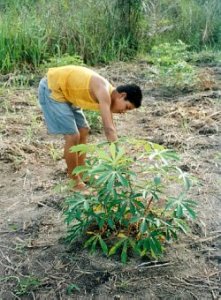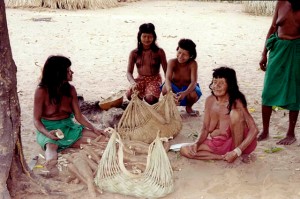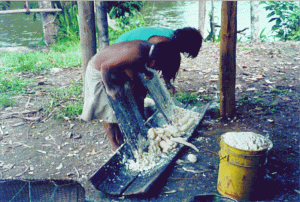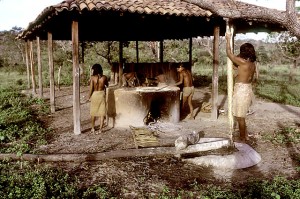The Realm Of The Animal And Plant People (continued)
YUCA the chief of the plants

 Yuca (manioc, cassava) is a starchy tuber-bearing bush with thick leafy foliage. The leaves are hand shaped with finger-like projections.
Yuca (manioc, cassava) is a starchy tuber-bearing bush with thick leafy foliage. The leaves are hand shaped with finger-like projections.

The plant is grown from cuttings as opposed to seeds, and then is tended carefully during its whole growth period which can last over a year. The edible part of the plant is the root which is thick and tuberous like a long potato.
There are two kinds of yuca; sweet manioc, which can be cooked and eaten as is, And bitter manioc which is much more nutritious but is also highly poisonous as it contains cyanide. Bitter manioc must be carefully processed for consumption.


The first step in processing bitter manioc is the digging up, peeling and grating of the roots. The brown outer peel must be scraped off and then the white fleshy root is grated on a tool called a “guayo”.

The white juicy grated yuca pulp is then pushed into a long basketry sack called “sibucan”. The top of the sack is attached to the branch of a tree and the bottom is weighed down with a rock or a pole is pushed through a loop at the bottom and women sit or stand on the pole to stretch and squeeze the sack. The pulp is squeezed and streams of poisonous yuca juice called “hien” flows out the bottom of the sack.
 Once the poisonous juice has been squeezed out of the yuca pulp the semi-moist powder remaining in the sack is pulled out and spread over a hot griddle called “buren”. This cooks off the last remaining poison and produces large, white, flat pizza-shaped loaves. These “tortillas” are crusty and brittle but keep very well and can be stored successfully for months even in the hot humid climate of the tropics.
Once the poisonous juice has been squeezed out of the yuca pulp the semi-moist powder remaining in the sack is pulled out and spread over a hot griddle called “buren”. This cooks off the last remaining poison and produces large, white, flat pizza-shaped loaves. These “tortillas” are crusty and brittle but keep very well and can be stored successfully for months even in the hot humid climate of the tropics.
 The Tainos served the crusty yuca bread which is called “casabe” with roasted duck and hutia meat, as well as fish and boiled vegetables.
The Tainos served the crusty yuca bread which is called “casabe” with roasted duck and hutia meat, as well as fish and boiled vegetables.
Tomatoes, corn tamales, sweet peppers and a wide variety of delicious fruit such as pineapple and guavas were also part of the Taino diet.

